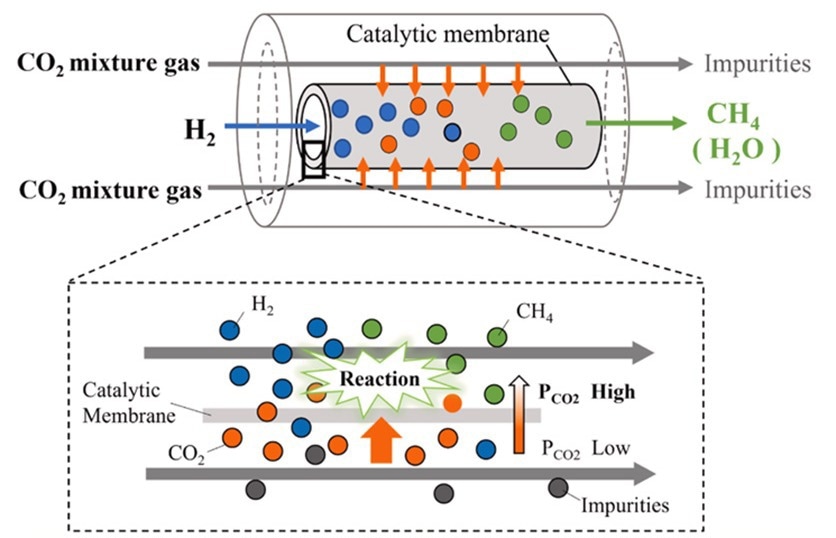Boilers are frequently underestimated as significant sources of greenhouse gas emissions. However, they are now regarded as key to environmental action. A recent study published in the Journal of CO2 Utilization highlights the work of an international research team from Japan and Poland who have developed a novel method to convert CO2 emissions from small boilers into methane. This pioneering technique significantly reduces the environmental impact of boilers and sets a new standard for sustainable industrial practices.

Schematic of the distributor-type membrane reactor for CO2 capture. Researchers from Japan and Poland have developed a reactor design that efficiently captures CO2 emissions and converts them into usable methane fuel. This breakthrough could significantly reduce greenhouse gas emissions, paving the way for a carbon-neutral future. Image Credit: Professor Mikihiro Nomura from SIT, Japan
Addressing carbon emissions from small-scale combustion systems such as boilers and other industrial devices is crucial for achieving a sustainable, carbon-neutral future. Boilers play a vital role in various industrial sectors by providing essential services like heating, steam generation, and power production, thereby contributing significantly to greenhouse gas emissions.
Despite the high efficiency of boilers, reducing CO2 emissions through improvements in combustion efficiency alone proves challenging. Consequently, researchers are pursuing alternative methods to lessen the environmental impact of these emissions. A notable approach involves capturing the CO2 from these systems and transforming it into a useful substance like methane.
This conversion process requires a specialized type of membrane reactor known as the distributor-type membrane reactor (DMR), which supports both chemical reactions and gas separation. Although DMRs are utilized in certain sectors, their use in converting CO2 to methane in small-scale applications like boilers is largely untapped.
This area of research was explored by a team led by Professor Mikihiro Nomura of Shibaura Institute of Technology in Japan and Professor Grzegorz Brus of AGH University of Science and Technology in Poland.
The research team employed a dual approach involving numerical simulations and experimental studies to refine reactor designs for the effective conversion of CO2 emissions from small boilers into methane. Their simulations modeled the flow and reactions of gases under various conditions, which helped minimize temperature fluctuations and optimize energy use while ensuring reliable methane production.
They discovered that using a distributed feed design, as opposed to traditional methods that introduce gases at a single point, enhances the distribution of CO2 across the membrane and prevents any part of the reactor from overheating.
This DMR design helped us reduce temperature increments by about 300 degrees compared to the traditional packed bed reactor.
Mikihiro Nomura, Professor, Shibaura Institute of Technology
In addition to investigating the distributed feed design, the researchers explored other factors influencing the reactor's efficiency. Notably, they identified the concentration of CO2 in the mixture as a critical variable. Altering the CO2 content in the mixture had a discernible impact on the efficacy of the reaction process.
When the CO2 concentration was around 15 %, similar to what comes out of the boilers, the reactor was much better at producing methane. In fact, it could produce about 1.5 times more methane compared to a regular reactor that only had pure CO2 to work with.
Mikihiro Nomura, Professor, Shibaura Institute of Technology
Additionally, the research team examined how the size of the reactor influences the process, finding that larger reactors improve the availability of hydrogen necessary for the reaction. This increase comes with a tradeoff, as the higher hydrogen availability necessitates precise temperature control to prevent the reactor from overheating.
This study offers a viable solution to address a significant source of greenhouse gas emissions. By employing a distributor-type membrane reactor, low-concentration CO2 emissions can be converted into usable methane fuel. The advantages that this offers extend beyond methane production, as it can be adapted for other chemical reactions, making it a flexible option for efficient CO2 utilization in both residential settings and small-scale industrial applications.
Journal Reference:
Sato, Y., et al. (2024). Unveil carbon dioxide recycling potential throughout distributor-type membrane reactor. Journal of CO2 Utilization. doi.org/10.1016/j.jcou.2024.102763.